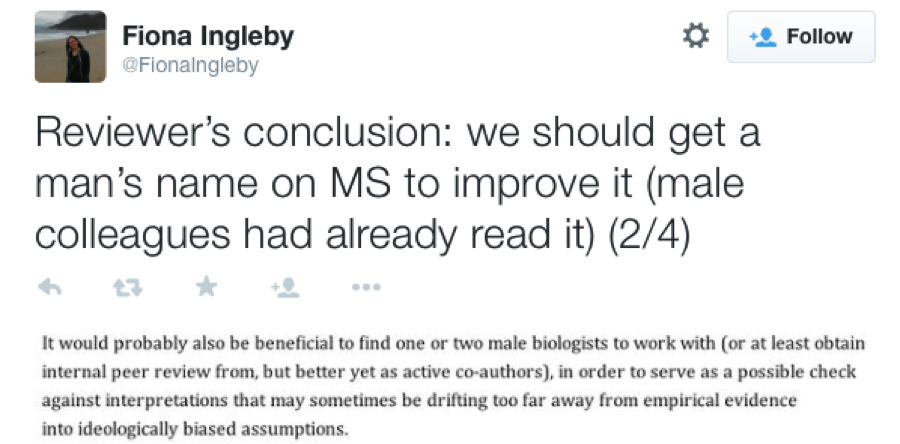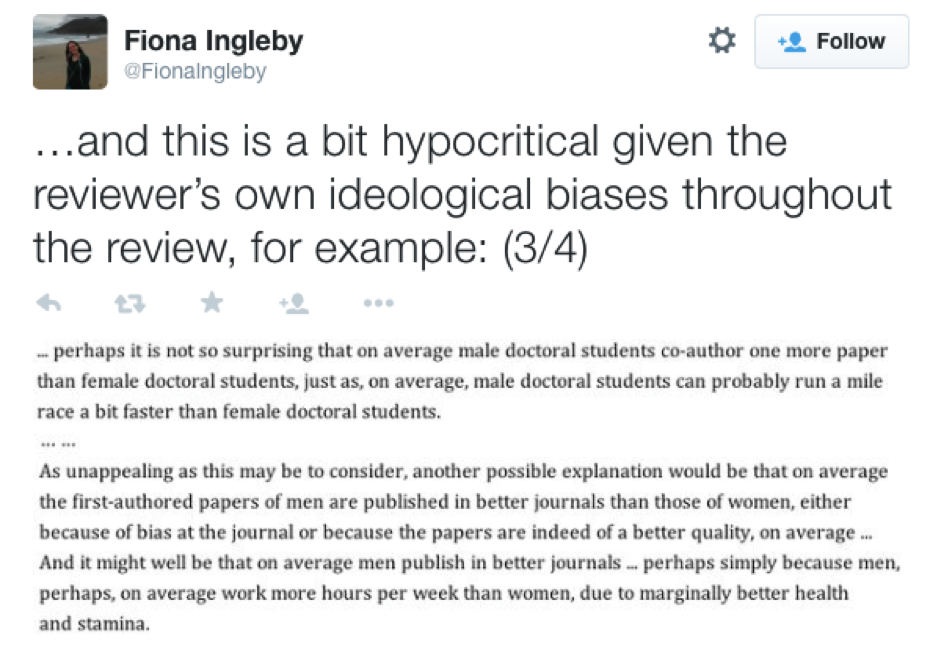|
6/20/2015 0 Comments Gender balance and biases in STEM: the situation is improving, but how can we make it even better?
By Rebecca Nebel
A recent study published in the Proceedings of the National Academy of Sciences (PNAS) by researchers from Cornell University, Wendy Williams & Stephen Ceci, reports that faculty members have a 2:1 preference for hiring women for STEM tenure track positions. This preference was shown in math intensive fields (where women are generally underrepresented) and math non-intensive fields (where women have a slightly higher presence). While summarizing their study, the authors state, “These results suggest it is a propitious time for women launching careers in academic science.” But is it really an advantageous time for STEM women in academia? My gut says no, but let’s take a closer look.
Many individuals in the STEM community remain skeptical and increasingly critical of the Williams & Ceci study. Articles in Slate and Other Sociologist, for example, argue that there are flaws in the design of the study, and it may not reflect real-world hiring processes. Surprisingly, this study goes against other findings published in PNAS that paint a different picture for women in STEM. For instance, a different study published just 3 years ago found that faculty rated a male applicant “applying” for a lab manager position significantly higher than an identical female applicant, and offered the male applicant a higher starting salary. Researchers stated that the female applicant was less likely to be hired because she was viewed as less competent. Additionally, in another study, researchers analyzed graduate student and postdoctoral gender disparities in the life sciences, a field generally well represented by women at the graduate and postdoc level. This study found “elite” male faculty (elite was defined as those who were funded by the Howard Hughes Medical Institute, were members of the National Academy of Sciences, or had won at least one of seven different major research awards) trained 10-40% fewer women in the lab relative to other faculty members. Interestingly, this same gap was not seen in the labs of “elite” female faculty. The difference could be due to self-selection from female investigators or a type of bias in male investigators, yet the important fact remains that these “elite” labs serve as major feeders for tenure-track positions at prestigious universities. It would stand to reason then that if there are fewer women in these labs, fewer women are in the tenure-track pipeline. Given the previously mentioned studies (and many others!) that came before, it seems hard to believe the findings from Williams & Ceci.
So, what are some of the biases that women in STEM are facing? Research looking into the authorship order of publications found that although in terms of raw publication count, men and women are publishing in equal amounts, women are still severely underrepresented in the last author position. This disparity is seen most prominently in areas, such as life sciences, where the prestigious last author position is reserved for the head of the lab. It’s unclear whether this is due to the general underrepresentation of women at the faculty level or due to a bias against women. However, authorship position and one’s number of publications are factors that can affect career advancement in academia. For example, it is expected that professors should have a certain number of last author papers in order to be promoted to tenure. Thus, if women are not publishing in the last author position (for whatever reason), they may have trouble getting tenured. The hard to prove, but often referenced reason for a lack of women in STEM is, of course, blatant sexism. Recently, in a situation that seems straight out of Mad Men, controversy erupted after a manuscript authored by two female researchers to PLOS ONE was rejected and received disparaging comments from a reviewer. The manuscript, written by Fiona Ingleby & Megan Head from the University of Sussex and the Australian National University, respectively, investigated gender differences in the Ph.D. to post-doc transition. Comments about their manuscript included:
The remarks were incredibly misogynistic, but worse still was that Ingleby & Head felt there was a lack of truly constructive feedback provided. Although the full review has not been made available to the public, there is no excuse for the sexist comments made by the reviewer.
Ingleby & Head appealed their rejection, but after waiting over three weeks to hear back from the journal, Ingleby posted the reviewer’s comments on Twitter out of frustration. Immediately after Ingleby tweeted these comments, the public reacted quickly in support of Ingleby & Head. Since then, PLOS ONE has removed said reviewer from their database of potential referees and have asked the academic editor who oversaw the manuscript review to step down. Most of us can agree that this type of behavior shouldn’t be happening, and I’m sure it’s not the only time or the only journal where something so obviously discriminatory has occurred. And who knows what the outcome would have been had the authors not posted their reviewer’s comments on Twitter. While the reviewer and academic editor remain unnamed, we can only hope the public outcry from this incident will change their behavior in the future. So what can we do? How can we try and battle these biases against women, both small and large? Clearly, there is no immediate solution but some companies are attempting to take steps in the right direction. Google has been criticized for its lack of gender diversity, as males make up 70% of the workforce at Google. Unhappy with this fact and the underrepresentation of minorities in their workplace, Google began diversity training aimed at educating their trainees about unconscious biases- implicit preferences that shape most people’s view of other people. The notion with this training is that the more aware we make ourselves of our unconscious biases in our decision-making, the greater chance we have of overcoming it. There’s been no official research on the effectiveness of their diversity training, but Google reports anecdotal evidence that seems to suggest the training is having a positive impact on their workforce. While it’s nice to think Google’s primary motive is to promote diversity for the goodness of humanity, which they may want to in some part, they know that having a diverse workforce is good for company productivity. Studies have shown that more diverse groups consistently outperform those that are homogenous, which in turn can generate more growth and/or more revenue for companies. So the next time you are at a meeting in that room, you know, the room lined with photos of old, white men, or you attend a conference and see the that all the speakers are men, start combatting these unconscious biases by making others aware. Mention it to someone in charge, and perhaps even suggest some female role models to include as well. As we become more aware of our biases and in turn diversify the work force, we can hope to have a more productive and innovative future. References: Williams & Ceci study- http://www.pnas.org/content/112/17/5360.abstract Representation of Women Across STEM fields- http://sites.duke.edu/ampwis/files/2014/11/Women-in-Academic-Science-A-Changing-Landscape.pdf Williams & Ceci rebuttal in Slate- http://www.slate.com/articles/double_x/doublex/2015/04/no_sexist_hiring_in_stem_fields_a_vaunted_new_study_makes_that_claim_unconvincingly.html?wpsrc=sh_all_dt_fb_bot Williams & Ceci rebuttal in Other Sociologist- http://othersociologist.com/2015/04/16/myth-about-women-in-science/?hc_location=ufi&utm_content=buffercd6c9&utm_medium=social&utm_source=twitter.com&utm_campaign=buffer Lab Manager study- http://www.pnas.org/content/109/41/16474 Elite lab study- http://www.pnas.org/content/111/28/10107.full Authorship position study- http://journals.plos.org/plosone/article?id=10.1371/journal.pone.0066212 Tim Hunt sexist comments- http://www.theguardian.com/uk-news/2015/jun/10/nobel-scientist-tim-hunt-female-scientists-cause-trouble-for-men-in-labs?CMP=share_btn_fb Ingleby & Head controversy- http://www.washingtonpost.com/news/speaking-of-science/wp/2015/04/30/sexism-in-science-peer-editor-tells-female-researchers-their-study-needs-a-male-author/ Ingleby & Head controversy- http://news.sciencemag.org/scientific-community/2015/04/sexist-peer-review-elicits-furious-twitter-response Unconscious bias at Google- http://www.nytimes.com/2014/09/25/technology/exposing-hidden-biases-at-google-to-improve-diversity.html?_r=2 Diversity in the Workplace- http://www.scientificamerican.com/article/how-diversity-makes-us-smarter/ 
About the Author
Rebecca Nebel is a Ph.D. student studying the genetics of neurodevelopmental diseases at Albert Einstein College of Medicine. She is a copy editor for the Scientista blog and was a member of the 2014 Scientista Symposium Planning Committee. Rebecca is passionate about improving communications between the scientific community and the general public and narrowing existing communication gaps. She also enjoys baking, singing in Einstein’s a capella group, and getting her butt kicked at crossfit. Comments? Leave them below!
0 Comments
Your comment will be posted after it is approved.
Leave a Reply. |
Archives
July 2022
CategoriesAll Amy Massack BiWeekly Roundup Danae Dodge Gabrielle-Ann Torre Indulekha Karunakaran Jeesoo Sohn Lauren Koenig Lidiya Angelova Melissa Bendayan Microsoft Molly Connell Nektaria Riso Nicole Hellessey Physics Poornima Peiris Robbin Koenig Sadaf Atarod Sarah Smith Shreya Challa Vijendra Agarwal Women In STEM Yolanda Lannquist |
The Network for Pre-Professional Women in Science and Engineering
The Scientista Foundation is a registered 501(c)(3) -- Donate!



 RSS Feed
RSS Feed